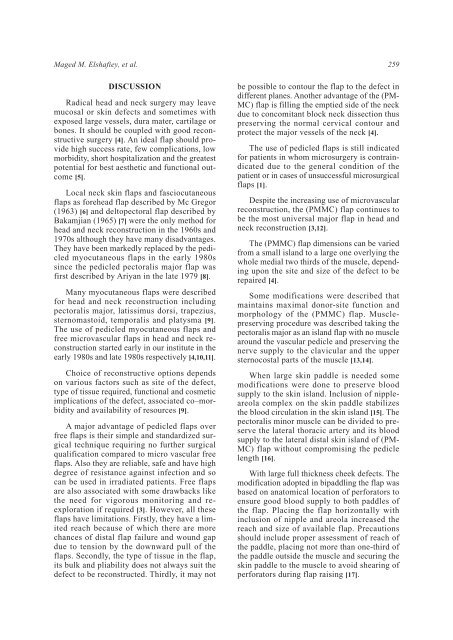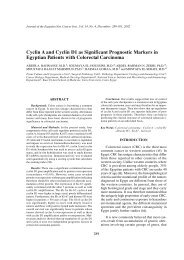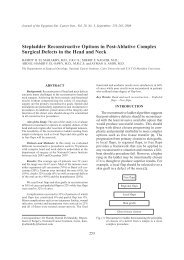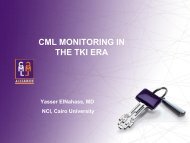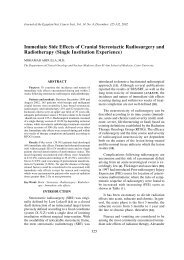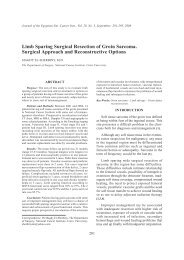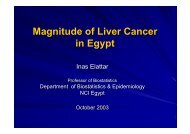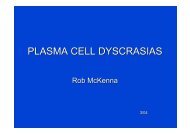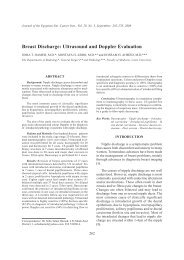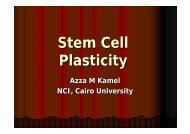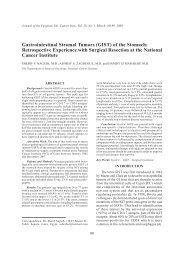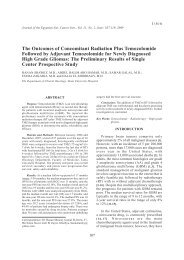Continuous Validity of Pedicled Myocutaneous and Myofascial ... - NCI
Continuous Validity of Pedicled Myocutaneous and Myofascial ... - NCI
Continuous Validity of Pedicled Myocutaneous and Myofascial ... - NCI
You also want an ePaper? Increase the reach of your titles
YUMPU automatically turns print PDFs into web optimized ePapers that Google loves.
Maged M. Elshafiey, et al. 259<br />
DISCUSSION<br />
Radical head <strong>and</strong> neck surgery may leave<br />
mucosal or skin defects <strong>and</strong> sometimes with<br />
exposed large vessels, dura mater, cartilage or<br />
bones. It should be coupled with good reconstructive<br />
surgery [4]. An ideal flap should provide<br />
high success rate, few complications, low<br />
morbidity, short hospitalization <strong>and</strong> the greatest<br />
potential for best aesthetic <strong>and</strong> functional outcome<br />
[5].<br />
Local neck skin flaps <strong>and</strong> fasciocutaneous<br />
flaps as forehead flap described by Mc Gregor<br />
(1963) [6] <strong>and</strong> deltopectoral flap described by<br />
Bakamjian (1965) [7] were the only method for<br />
head <strong>and</strong> neck reconstruction in the 1960s <strong>and</strong><br />
1970s although they have many disadvantages.<br />
They have been markedly replaced by the pedicled<br />
myocutaneous flaps in the early 1980s<br />
since the pedicled pectoralis major flap was<br />
first described by Ariyan in the late 1979 [8].<br />
Many myocutaneous flaps were described<br />
for head <strong>and</strong> neck reconstruction including<br />
pectoralis major, latissimus dorsi, trapezius,<br />
sternomastoid, temporalis <strong>and</strong> platysma [9].<br />
The use <strong>of</strong> pedicled myocutaneous flaps <strong>and</strong><br />
free microvascular flaps in head <strong>and</strong> neck reconstruction<br />
started early in our institute in the<br />
early 1980s <strong>and</strong> late 1980s respectively [4,10,11].<br />
Choice <strong>of</strong> reconstructive options depends<br />
on various factors such as site <strong>of</strong> the defect,<br />
type <strong>of</strong> tissue required, functional <strong>and</strong> cosmetic<br />
implications <strong>of</strong> the defect, associated co–morbidity<br />
<strong>and</strong> availability <strong>of</strong> resources [9].<br />
A major advantage <strong>of</strong> pedicled flaps over<br />
free flaps is their simple <strong>and</strong> st<strong>and</strong>ardized surgical<br />
technique requiring no further surgical<br />
qualification compared to micro vascular free<br />
flaps. Also they are reliable, safe <strong>and</strong> have high<br />
degree <strong>of</strong> resistance against infection <strong>and</strong> so<br />
can be used in irradiated patients. Free flaps<br />
are also associated with some drawbacks like<br />
the need for vigorous monitoring <strong>and</strong> reexploration<br />
if required [3]. However, all these<br />
flaps have limitations. Firstly, they have a limited<br />
reach because <strong>of</strong> which there are more<br />
chances <strong>of</strong> distal flap failure <strong>and</strong> wound gap<br />
due to tension by the downward pull <strong>of</strong> the<br />
flaps. Secondly, the type <strong>of</strong> tissue in the flap,<br />
its bulk <strong>and</strong> pliability does not always suit the<br />
defect to be reconstructed. Thirdly, it may not<br />
be possible to contour the flap to the defect in<br />
different planes. Another advantage <strong>of</strong> the (PM-<br />
MC) flap is filling the emptied side <strong>of</strong> the neck<br />
due to concomitant block neck dissection thus<br />
preserving the normal cervical contour <strong>and</strong><br />
protect the major vessels <strong>of</strong> the neck [4].<br />
The use <strong>of</strong> pedicled flaps is still indicated<br />
for patients in whom microsurgery is contraindicated<br />
due to the general condition <strong>of</strong> the<br />
patient or in cases <strong>of</strong> unsuccessful microsurgical<br />
flaps [1].<br />
Despite the increasing use <strong>of</strong> microvascular<br />
reconstruction, the (PMMC) flap continues to<br />
be the most universal major flap in head <strong>and</strong><br />
neck reconstruction [3,12].<br />
The (PMMC) flap dimensions can be varied<br />
from a small isl<strong>and</strong> to a large one overlying the<br />
whole medial two thirds <strong>of</strong> the muscle, depending<br />
upon the site <strong>and</strong> size <strong>of</strong> the defect to be<br />
repaired [4].<br />
Some modifications were described that<br />
maintains maximal donor-site function <strong>and</strong><br />
morphology <strong>of</strong> the (PMMC) flap. Musclepreserving<br />
procedure was described taking the<br />
pectoralis major as an isl<strong>and</strong> flap with no muscle<br />
around the vascular pedicle <strong>and</strong> preserving the<br />
nerve supply to the clavicular <strong>and</strong> the upper<br />
sternocostal parts <strong>of</strong> the muscle [13,14].<br />
When large skin paddle is needed some<br />
modifications were done to preserve blood<br />
supply to the skin isl<strong>and</strong>. Inclusion <strong>of</strong> nippleareola<br />
complex on the skin paddle stabilizes<br />
the blood circulation in the skin isl<strong>and</strong> [15]. The<br />
pectoralis minor muscle can be divided to preserve<br />
the lateral thoracic artery <strong>and</strong> its blood<br />
supply to the lateral distal skin isl<strong>and</strong> <strong>of</strong> (PM-<br />
MC) flap without compromising the pedicle<br />
length [16].<br />
With large full thickness cheek defects. The<br />
modification adopted in bipaddling the flap was<br />
based on anatomical location <strong>of</strong> perforators to<br />
ensure good blood supply to both paddles <strong>of</strong><br />
the flap. Placing the flap horizontally with<br />
inclusion <strong>of</strong> nipple <strong>and</strong> areola increased the<br />
reach <strong>and</strong> size <strong>of</strong> available flap. Precautions<br />
should include proper assessment <strong>of</strong> reach <strong>of</strong><br />
the paddle, placing not more than one-third <strong>of</strong><br />
the paddle outside the muscle <strong>and</strong> securing the<br />
skin paddle to the muscle to avoid shearing <strong>of</strong><br />
perforators during flap raising [17].


